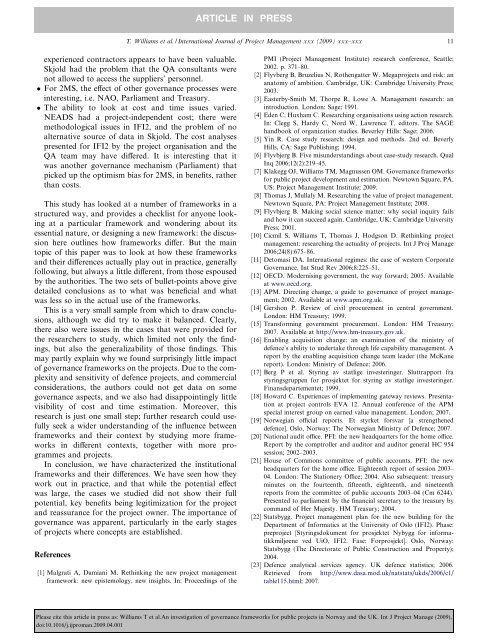Link to thesis. - Concept - NTNU
Link to thesis. - Concept - NTNU
Link to thesis. - Concept - NTNU
- No tags were found...
Create successful ePaper yourself
Turn your PDF publications into a flip-book with our unique Google optimized e-Paper software.
ARTICLE IN PRESST. Williams et al. / International Journal of Project Management xxx (2009) xxx–xxx 11experienced contrac<strong>to</strong>rs appears <strong>to</strong> have been valuable.Skjold had the problem that the QA consultants werenot allowed <strong>to</strong> access the suppliers’ personnel. For 2MS, the effect of other governance processes wereinteresting, i.e. NAO, Parliament and Treasury. The ability <strong>to</strong> look at cost and time issues varied.NEADS had a project-independent cost; there weremethodological issues in IFI2, and the problem of noalternative source of data in Skjold. The cost analysespresented for IFI2 by the project organisation and theQA team may have differed. It is interesting that itwas another governance mechanism (Parliament) thatpicked up the optimism bias for 2MS, in benefits, ratherthan costs.This study has looked at a number of frameworks in astructured way, and provides a checklist for anyone lookingat a particular framework and wondering about itsessential nature, or designing a new framework: the discussionhere outlines how frameworks differ. But the main<strong>to</strong>pic of this paper was <strong>to</strong> look at how these frameworksand their differences actually play out in practice, generallyfollowing, but always a little different, from those espousedby the authorities. The two sets of bullet-points above givedetailed conclusions as <strong>to</strong> what was beneficial and whatwas less so in the actual use of the frameworks.This is a very small sample from which <strong>to</strong> draw conclusions,although we did try <strong>to</strong> make it balanced. Clearly,there also were issues in the cases that were provided forthe researchers <strong>to</strong> study, which limited not only the findings,but also the generalizability of those findings. Thismay partly explain why we found surprisingly little impac<strong>to</strong>f governance frameworks on the projects. Due <strong>to</strong> the complexityand sensitivity of defence projects, and commercialconsiderations, the authors could not get data on somegovernance aspects, and we also had disappointingly littlevisibility of cost and time estimation. Moreover, thisresearch is just one small step; further research could usefullyseek a wider understanding of the influence betweenframeworks and their context by studying more frameworksin different contexts, <strong>to</strong>gether with more programmesand projects.In conclusion, we have characterized the institutionalframeworks and their differences. We have seen how theywork out in practice, and that while the potential effectwas large, the cases we studied did not show their fullpotential, key benefits being legitimization for the projectand reassurance for the project owner. The importance ofgovernance was apparent, particularly in the early stagesof projects where concepts are established.References[1] Malgrati A, Damiani M. Rethinking the new project managementframework: new epistemology, new insights. In: Proceedings of thePMI (Project Management Institute) research conference, Seattle;2002. p. 371–80.[2] Flyvberg B, Bruzelius N, Rothengatter W. Megaprojects and risk: anana<strong>to</strong>my of ambition. Cambridge, UK: Cambridge University Press;2003.[3] Easterby-Smith M, Thorpe R, Lowe A. Management research: anintroduction. London: Sage; 1991.[4] Eden C, Huxham C. Researching organisations using action research.In: Clegg S, Hardy C, Nord W, Lawrence T, edi<strong>to</strong>rs. The SAGEhandbook of organization studies. Beverley Hills: Sage; 2006.[5] Yin R. Case study research: design and methods. 2nd ed. BeverlyHills, CA: Sage Publishing; 1994.[6] Flyvbjerg B. Five misunderstandings about case-study research. QualInq 2006;12(2):219–45.[7] Klakegg OJ, Williams TM, Magnussen OM. Governance frameworksfor public project development and estimation. New<strong>to</strong>wn Square, PA,US: Project Management Institute; 2009.[8] Thomas J, Mullaly M. Researching the value of project management.New<strong>to</strong>wn Square, PA: Project Management Institute; 2008.[9] Flyvbjerg B. Making social science matter: why social inquiry failsand how it can succeed again. Cambridge, UK: Cambridge UniversityPress; 2001.[10] Cicmil S, Williams T, Thomas J, Hodgson D. Rethinking projectmanagement: researching the actuality of projects. Int J Proj Manage2006;24(8):675–86.[11] De<strong>to</strong>masi DA. International regimes: the case of western CorporateGovernance. Int Stud Rev 2006;8:225–51.[12] OECD. Modernising government, the way forward; 2005. Availableat www.oecd.org.[13] APM. Directing change, a guide <strong>to</strong> governance of project management;2002. Available at www.apm.org.uk.[14] Gershon P. Review of civil procurement in central government.London: HM Treasury; 1999.[15] Transforming government procurement. London: HM Treasury;2007. Available at http://www.hm-treasury.gov.uk.[16] Enabling acquisition change: an examination of the ministry ofdefence’s ability <strong>to</strong> undertake through life capability management. Areport by the enabling acquisition change team leader (the McKanereport). London: Ministry of Defence; 2006.[17] Berg P et al. Styring av statlige investeringer. Sluttrapport frastyringsgruppen for prosjektet for styring av statlige investeringer.Finansdepartementet; 1999.[18] Howard C. Experiences of implementing gateway reviews. Presentationat project controls EVA 12. Annual conference of the APMspecial interest group on earned value management. London; 2007.[19] Norwegian official reports. Et styrket forsvar [a strengtheneddefence]. Oslo, Norway: The Norwegian Ministry of Defence; 2007.[20] National audit office. PFI: the new headquarters for the home office.Report by the comptroller and audi<strong>to</strong>r and audi<strong>to</strong>r general HC 954session; 2002–2003.[21] House of Commons committee of public accounts. PFI: the newheadquarters for the home office. Eighteenth report of session 2003–04. London: The Stationery Office; 2004. Also subsequent: treasuryminutes on the fourteenth, fifteenth, eighteenth, and nineteenthreports from the committee of public accounts 2003–04 (Cm 6244).Presented <strong>to</strong> parliament by the financial secretary <strong>to</strong> the treasury bycommand of Her Majesty. HM Treasury; 2004.[22] Statsbygg. Project management plan for the new building for theDepartment of Informatics at the University of Oslo (IFI2). Phase:preproject [Styringsdokument for prosjektet Nybygg for informatikkmiljøeneved UiO, IFI2. Fase: Forprosjekt]. Oslo, Norway:Statsbygg (The Direc<strong>to</strong>rate of Public Construction and Property);2004.[23] Defence analytical services agency. UK defence statistics; 2006.Retrieved from http://www.dasa.mod.uk/natstats/ukds/2006/c1/table115.html; 2007.Please cite this article in press as: Williams T et al.An investigation of governance frameworks for public projects in Norway and the UK. Int J Project Manage (2009),doi:10.1016/j.ijproman.2009.04.001
















